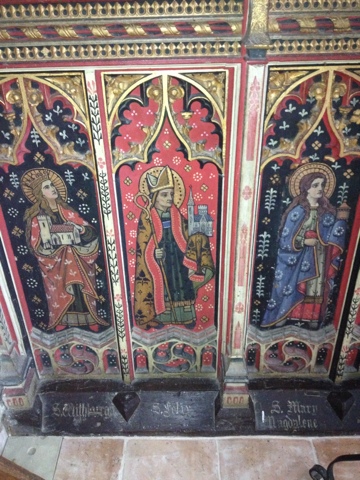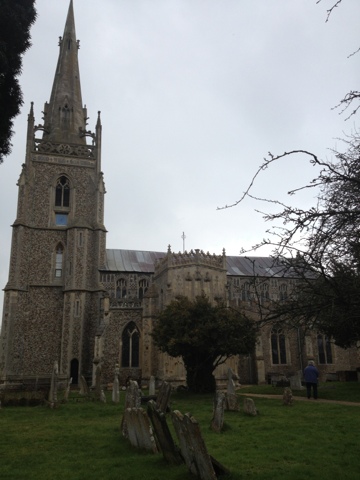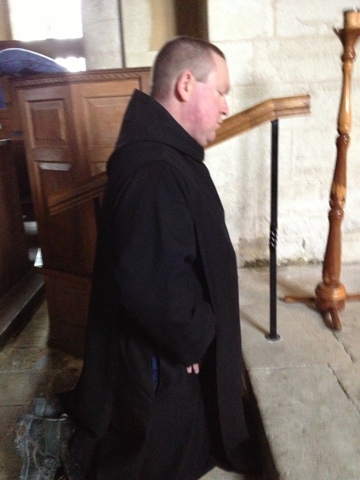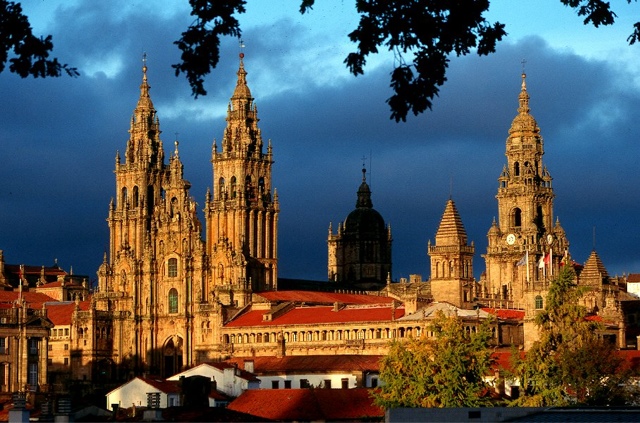For the Camino pilgrims, this, the final day of the Pontificate of Pope Benedict XVI, begins with Conventual Mass celebrated by His Lordship, the Abbot of Farnborough, where for the last time we shall prayer for Our Holy Father in the Canon of the Mass.
Immediately following Mass we shall ask the Abbot's blessing and begin our journey to Santiago, expecting to arrive in Vezelay this evening, where we will begin the Camino Frances (Vezelay route) in the morning.
Holy Mary, Mother of the Church
St Benedict, Pray for us
St Justin, Pray for us
St James, Pray for us
Thursday 28 February 2013
Saturday 23 February 2013
Our Lady of Woolpit
Woolpit in Suffolk was, in medieval times, a place of pilgrimage, on the road to Walsingham.
In the Church of St Mary, the Blessed Virgin was venerated under the title of Our Lady of Woolpit. A miraculous well stood in a meadow near the east end of the church.
Today the church still boasts a medieval rood screen and one of the best examples of an angel hammer beam roof.
In the Church of St Mary, the Blessed Virgin was venerated under the title of Our Lady of Woolpit. A miraculous well stood in a meadow near the east end of the church.
Today the church still boasts a medieval rood screen and one of the best examples of an angel hammer beam roof.
St Mary, Selborne
A member has reported fulfilling SSIM duties at the 12th century church of St Mary, Selborne in Hampshire, on the Feast of the Chair of St Peter.
Monday 18 February 2013
The Way of St James - El Camino de Santiago
Tradition tells us that the relics of St James the Apostle were brought to Galicia in Northern Spain and buried on a site within the present day city of Compostella. A great Cathedral now stands over his tomb and attacks many thousands of pilgrims each year. The number reached over 270,00 in the last Santiago Holy Year in 2010.
During the medieval period, the way to Compostella was one of the great pilgrimages of Christendom, endowed with indulgences and those who travelled there came from all over the world. The major routes they took across Europe are still travelled today by many Christian pilgrims, on foot, bicycle or horse and many others seeking some sort of escape from the modern world and perhaps in search of a Truth they cannot yet name. Some of theses pilgrims walk hundreds of miles, staying in pilgrim hostels or sleeping under the stars. They carry a 'credencial' or pilgrim passport which is stamped along the route to prove that they have made the journey.
On arrival at the shrine of the apostle, they are issued with a 'Compostella' a certificate proving the pilgrimage has been completed and attend a daily pilgrim mass in the cathedral. During the mass the world famous botafumeiro or giant thurible, containing burning incense is swung, symbolising the prayers of the pilgrims ascending to God. Some believe this ceremony originally had a more practical purpose; to disguise the smell of unwashed pilgrims who may have been on the road for many months!
In early March, Dom Anselm Carpenter, a Benedictine Monk, Br Bede, a Benedictine oblate and Mr JP Loveland will be walking the final sections of the Camino (111kms). As well as a Lenten penance, the original intention for this pilgrimage was for vocations to the religious life at the Benedictine Abbey of St Michael, in Farnborough, UK but to that now we must also add our prayers for the election of a Pope and an act of thanksgiving for the ministry of our Holy Father Pope Benedict XVI. Before the walk two of us will be travelling, by car, the longer Vezalay route of the Camino Frances, and after the walk, visiting the Shrine of Our Lady of Lourdes.
Technology permitting, we hope to blog most days at dialoguewithtrypho.blogspot.com and we will be praying the monastic office each day and reciting the rosary as well as attending Mass when this is possible.
We will be praying for all of our friends and for members of SSIM and we sincerely hope that you will accompany us on this pilgrimage with your prayers. Please, particularly pray for vocations to the monastic community at Farnborough and for the election of a new Pope as well as for the walkers.
During the medieval period, the way to Compostella was one of the great pilgrimages of Christendom, endowed with indulgences and those who travelled there came from all over the world. The major routes they took across Europe are still travelled today by many Christian pilgrims, on foot, bicycle or horse and many others seeking some sort of escape from the modern world and perhaps in search of a Truth they cannot yet name. Some of theses pilgrims walk hundreds of miles, staying in pilgrim hostels or sleeping under the stars. They carry a 'credencial' or pilgrim passport which is stamped along the route to prove that they have made the journey.
On arrival at the shrine of the apostle, they are issued with a 'Compostella' a certificate proving the pilgrimage has been completed and attend a daily pilgrim mass in the cathedral. During the mass the world famous botafumeiro or giant thurible, containing burning incense is swung, symbolising the prayers of the pilgrims ascending to God. Some believe this ceremony originally had a more practical purpose; to disguise the smell of unwashed pilgrims who may have been on the road for many months!
In early March, Dom Anselm Carpenter, a Benedictine Monk, Br Bede, a Benedictine oblate and Mr JP Loveland will be walking the final sections of the Camino (111kms). As well as a Lenten penance, the original intention for this pilgrimage was for vocations to the religious life at the Benedictine Abbey of St Michael, in Farnborough, UK but to that now we must also add our prayers for the election of a Pope and an act of thanksgiving for the ministry of our Holy Father Pope Benedict XVI. Before the walk two of us will be travelling, by car, the longer Vezalay route of the Camino Frances, and after the walk, visiting the Shrine of Our Lady of Lourdes.
Technology permitting, we hope to blog most days at dialoguewithtrypho.blogspot.com and we will be praying the monastic office each day and reciting the rosary as well as attending Mass when this is possible.
We will be praying for all of our friends and for members of SSIM and we sincerely hope that you will accompany us on this pilgrimage with your prayers. Please, particularly pray for vocations to the monastic community at Farnborough and for the election of a new Pope as well as for the walkers.
Sunday 17 February 2013
All Saints Hannington
The picture shows Dom Anselm Carpenter OSB after having carried out the SSIM duties at All Saints Church in Hannington, Hampshire. The Church dates from the 11th century.
Tuesday 5 February 2013
Durham Cathedral
Durham was a Benedictine house prior to the dissolution of the monasteries and remains today one of the great buildings of Europe.
The monks came to Durham bearing the body of St Cuthbert after many years of searching for a suitable spot. In time the cult of St Cuthbert grew to such an extent that the Church was expanded to accommodate the pilgrims. His shrine was richly endowed and was the site of many miracles, wrought at his intercession.
Today his body lies beneath a granite slab in its original place and a large and beautiful Comper tester of Christ in Glory hangs above it.
The Shrine of St Bede the Venerable is also in the Cathedral. It is housed in the Galilee Chapel where there is also the site of a medieval altar dedicated to Our Lady of Pity (there were previously two altars bearing that dedication).
The monks came to Durham bearing the body of St Cuthbert after many years of searching for a suitable spot. In time the cult of St Cuthbert grew to such an extent that the Church was expanded to accommodate the pilgrims. His shrine was richly endowed and was the site of many miracles, wrought at his intercession.
Today his body lies beneath a granite slab in its original place and a large and beautiful Comper tester of Christ in Glory hangs above it.
The Shrine of St Bede the Venerable is also in the Cathedral. It is housed in the Galilee Chapel where there is also the site of a medieval altar dedicated to Our Lady of Pity (there were previously two altars bearing that dedication).
Monday 4 February 2013
Richard III
So it's been confirmed that the skeleton discovered last year in Leicester is that of King Richard (a Catholic monarch).
A petition is in place calling for him to be buried in a Catholic burial ground rather than Leicester's Anglican Cathedral.
I'd be perfectly happy if His Late Majesty were to be buried in Leicester Cathedral or Westminster Abbey both of which were built as Catholic places of worship. What is more important is that he is buried according to the rites and ceremonies of the Catholic Church by a Catholic priest.
Could this be the first Catholic 'state' funeral for a very long time? A requiem mass in Westminster Abbey celebrated by the Cardinal with the assistance of the entire episcopate and in the presence of Her Majesty the Queen perhaps.
A petition is in place calling for him to be buried in a Catholic burial ground rather than Leicester's Anglican Cathedral.
I'd be perfectly happy if His Late Majesty were to be buried in Leicester Cathedral or Westminster Abbey both of which were built as Catholic places of worship. What is more important is that he is buried according to the rites and ceremonies of the Catholic Church by a Catholic priest.
Could this be the first Catholic 'state' funeral for a very long time? A requiem mass in Westminster Abbey celebrated by the Cardinal with the assistance of the entire episcopate and in the presence of Her Majesty the Queen perhaps.
Subscribe to:
Posts (Atom)










